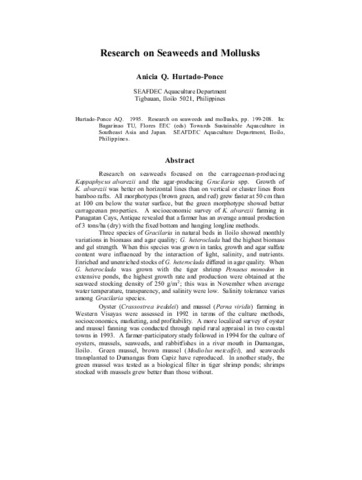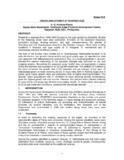Yield and agar quality of three red seaweed Gracilaria species grown in tanks at three salinities
| dc.contributor.author | Ferrer, Maria Salvacion R. | |
| dc.contributor.author | Marasigan, A. N. | |
| dc.contributor.editor | Bagarinao, Teodora | |
| dc.date.accessioned | 2018-05-28T06:16:19Z | |
| dc.date.available | 2018-05-28T06:16:19Z | |
| dc.date.issued | 2007 | |
| dc.identifier.citation | Ferrer, M. S. R., & Marasigan, A. N. (2007). Yield and agar quality of three red seaweed Gracilaria species grown in tanks at three salinities. In T. U. Bagarinao (Ed.), Research Output of the Fisheries Sector Program (Vol. 2. Reports on Fisheries and Aquaculture, pp. 129-137). Quezon City, Philippines: Bureau of Agricultural Research, Department of Agriculture. | en |
| dc.identifier.isbn | 9718511776 | |
| dc.identifier.uri | http://hdl.handle.net/10862/3297 | |
| dc.description.abstract | Gracilaria changii, G. firma and G. tenuistipitata were collected from the eastern coast of Sorsogon in southeastern Philippines and grown in concrete tanks at the SEAFDEC Aquaculture Department in Iloilo in May-June and in September-October 1994 at a stocking density of 1 kg/m2 and at three salinities (15, 25, and 35 ppt). In the first run, the highest specific growth rates per day were 2.5% at 25 ppt for G. changii, 3.6% at 35 ppt for G. firma, and 3.2% at 15 ppt for G. tenuistipitata. In the second run, the highest daily growth rates were 1.4% for G. changii, 1.2% for G. firma, and 3.3% for G. tenuistipitata, all at 15 ppt. Nutrient and light limitation in the second run led to lower and even negative growth rates. Gracilaria changii and G. firma were euryhaline but grew best at 25–35 ppt; G.tenuistipitata was not euryhaline and grew best at 15 ppt. The highest growth rates in tanks were at salinities close to those in the natural habitat: G. changii at 25 ppt, G. firma at 35 ppt, and G. tenuistipitata at 15 ppt. The estimated potential production (dry weight kg/m2-yr) in tanks was 1.65 kg G. changii at 25 ppt, 2.49 kg G. firma at 35 ppt, and 2.35 kg G. tenuistipitata at 15 ppt. Agar yields from three Gracilaria species varied from 5% to 23%, on average lowest in G. tenuistipitatata, and were generally higher at 25 ppt and 35 ppt than at 15 ppt. Agar gel strengths were also strongly affected by salinity and were highest at 35 ppt. Gracilaria tenuistipitata had very high gel strength (average 782 g/cm2 but as high as 1,082 g/cm2 comparable to agarose), well above the specified 750 g/cm2 for the international market. Gracilaria changii and G. firma had average gel strengths of 516 and 558 g/cm2, well within the range (400–600 g/cm2) for commercial agar used in the food industry. The sulfate contents were lower at 15 ppt and were even 0% in several instances, especially in G. tenuistipitata. The gelling temperature of 32°C and melting temperature of 97.3°C qualifies G. tenuistipitata for the international market. Gracilaria changii and G. firma had melting temperatures of 93–95°C but gelling temperatures of just 29°C. Farming techniques for these seaweeds should be developed to produce enough raw material for profitable commercial processing. | en |
| dc.language.iso | en | en |
| dc.publisher | Bureau of Agricultural Research, Department of Agriculture | en |
| dc.subject | Gracilaria | en |
| dc.title | Yield and agar quality of three red seaweed Gracilaria species grown in tanks at three salinities | en |
| dc.type | Book chapter | en |
| dc.citation.spage | 129 | |
| dc.citation.epage | 137 | |
| dc.citation.bookTitle | Research Output of the Fisheries Sector Program | en |
| dc.subject.asfa | seaweeds | en |
| dc.subject.asfa | seaweed culture | en |
| dc.subject.asfa | growth rate | en |
| dc.subject.asfa | agar | en |
| dc.subject.asfa | yields | en |
| dc.subject.asfa | salinity | en |
| dc.subject.scientificName | Gracilaria changii | en |
| dc.subject.scientificName | Gracilaria firma | en |
| dc.subject.scientificName | Gracilaria tenuistipitata | en |
Files in this item
| Files | ขนาด | รูป | View |
|---|---|---|---|
|
There are no files associated with this item. |
|||



